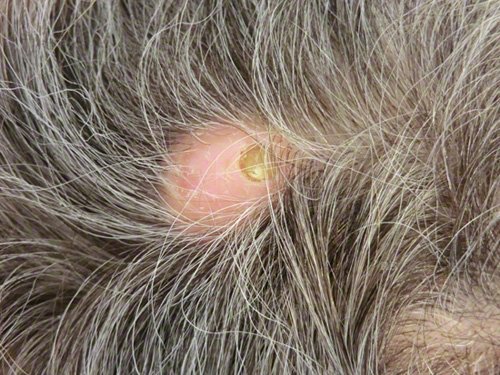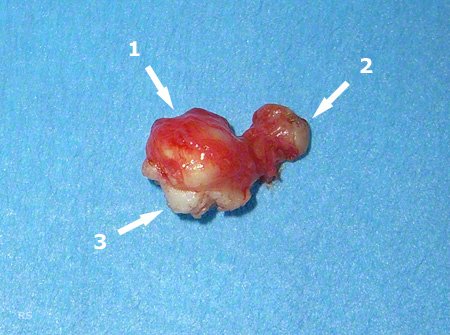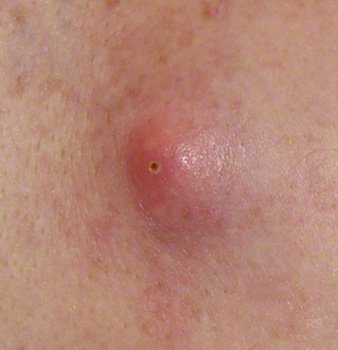What are groat pouches or atheromas?

Atheroma, epidermal cyst, epidermal cyst or trichilemmal cyst are many names for one and the same disease. An atheroma is the result of a blocked sebaceous gland. This gland is responsible for the natural lubrication of the skin.
If the sebaceous gland becomes blocked, it empties its sebum inwards so that it accumulates under the skin. The sebum is a whitish-greyish substance that consists of small crumbs in the sebaceous pouch.
Other synonyms: sebaceous cyst, steatoma, follicular cyst, sebaceous retention cyst, retention cyst
How do I recognize a groats bag?
The sebaceous cyst occurs preferably in areas with many sebaceous glands: the hairy scalp, face or neck. However, the atheroma can also become visible on other parts of the body. The size of the sebaceous sac varies from the size of a mustard seed (barely palpable) to the size of a table tennis ball.
On palpation, the elevation may feel rough or plump. A typical sign of an atheroma is a central black and gray spot. This is the blocked sebaceous gland duct, although it is not visible in all cases.
For reasons that are not yet fully understood, some people are prone to atheroma formation. They either have several atheromas at the same time or new ones form repeatedly – in the same and different places. A cluster can be observed in people with oily skin.
What symptoms typically occur?
In the case of epidermal cysts, symptoms only occur in advanced stages. The patient usually comes to the doctor for cosmetic reasons when the cyst is the size of a hazelnut. However, depending on the location, the cyst can also lead to unpleasant feelings of tension.
A problem can be a not-so-rare infection, which then requires treatment as with an abscess. The symptoms are similar to an abscess: swelling, redness, pain and overheating.
If it is an atheroma on the face and possibly also in the cheek-nose area, there is even a risk of infection spreading to the brain. This is due to the fact that draining vessels transport the blood (and also the germs) from the cheek-nose area via a vein (angular vein) at the inner corner of the eye into the inside of the skull.
An infected pouch can be dangerous on the face!
How does the operation proceed?

There is no effective treatment for atheroma without surgery. Patients often try to squeeze it out, thinking it is a pimple. However, this only leads to short-term success.
Small to medium-sized groats can be operated on under local anesthesia at the Yuveo Clinic Düsseldorf. For larger ones, twilight sleep and, in rare cases, anesthesia are recommended.
Non-infected atheroma:
The operation for a non-infected atheroma is usually inconspicuous. It is removed with a small skin spindle which, if present, contains the small black dot.
The atheroma capsule must be spared and removed in its entirety. If parts of the capsule or the sebaceous gland duct remain, a new atheroma is almost inevitable.
What needs to be considered with an infected atheroma?
The infected pouch cannot be operated on as described above. Why?
- Due to the infection, the pH value is shifted and a local anesthetic is therefore not effective.
- The inflammatory process causes the tissue to become doughy and loosely swollen. As a result, it is practically impossible to completely remove the capsule.

It is therefore advantageous to split (cut open) the infected atheroma like an abscess under icing and remove the pus and sebum. It is then carefully rinsed with an antiseptic (kills bacteria) and a drainage or flap is inserted.
These are intended to ensure the drainage of any fluid that still accumulates and facilitate subsequent rinsing. Finally, an antibiotic ointment is applied. Accompanying therapy with an antibiotic is important. Healing can take 1-3 weeks.
However, this is not the end of the treatment for the atheroma. The atheroma capsule is still under the skin. This is usually removed when it can be assumed that the infection has completely subsided. It is usually estimated to take 4-6 weeks.
Since an infected atheroma requires much more effort and patience from both the patient and the practitioner, it is advisable to treat the atheroma at an earlier stage.
In the case of a large pouch, similar to a lipoma, tissue displacement occurs, usually of fatty tissue. A defect (dent) may remain after the operation. An attempt is made to fill the cavity using certain suturing techniques in which the subcutaneous fatty tissue is displaced.

